The summer is almost over, and we have made some wonderful progress in our race to discover more island uniqueness before development changes everything. When I say “we”, I mean all the dedicated scientists, students and educators involved in our island biodiversity race for the past ten years. However, at the moment the laurels rest squarely on the head of Eden Maloney from the University of California at Los Angeles. Eden has been my intern at the California Academy of Sciences this summer, where she is known as “The Shrewster.”
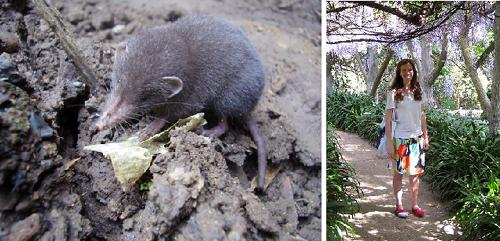
Crocidura thomensis (l); Eden Maloney, UCLA
One of our most intriguing questions has been whether the supposed endemic São Tomé shrew, Crocidura thomensis, is really endemic, found nowhere else in the world. This would suggest that its ancestor arrived on the island by natural means (rafting?) a long, long time ago. The alternative (and more likely) hypothesis is that it was brought to the islands, perhaps inadvertently, by the Portuguese during their 500 years of intense commerce on the islands, and the scientist who described it as unique was in error.
This is an important issue, because mammals, with the exception of some bats, are notoriously poor over-ocean dispersers because they are endotherms, needing to maintain a constant body temperature. Moreover, among mammals, the very worst candidates as island colonizers are shrews. A shrew’s metabolic rate is so high that it must eat every four hours or die from heat loss; thus no competent biologist would predict the presence of such a creature surviving an extended crossing to colonize an oceanic island.

José Vicente Barbosa du Bocage (1823 - 1907); Wikipedia image
Crocidura thomensis was originally described in 1887 by J. V. Barbosa du Bocage, the curator of Zoology at the Museum of Natural History in Lisbon. He based his description on anatomical features such as the large size of the shrew’s feet and ears as well as the particularly long snout. We decided to do a molecular (genetic) test of Bocage’s hypothesis that C. thomensis is found only on Sao Tome and nowhere else in the world. Thanks to the kindness of our friends from the Ministry of the Environment, Arlindo Carvalho, Vitor Bomfin and Salvador Pontes, we were granted permission to receive some shrew specimens collected by our colleague, Ricardo Lima of Nova Moca and to export them to the Academy where Eden did DNA analysis of them. She also included two shrews we collected on Príncipe during GG II (2006). These have long been thought to be an introduced mainland species.
Eden was able to take advantage of a massive molecular study published three years ago by Dr. Sylvain Dubey of the University of Lausanne and his colleagues. Dubey’s study included 139 members of the shrew Family Soricidae from all over the world, but of course he lacked examples of our island shrews. Eden contacted Dr. Dubey, who was most helpful, and she was able to use the same four genes in her analysis that Dubey used in his larger study. Below is an image of the alignment of the DNA sequences of Dubey’s samples together with our island samples.
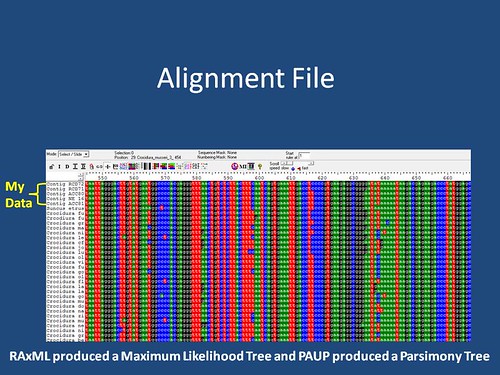
Shrew DNA sequence alignment. E. Maloney construct.

Maximum Likelihood Tree; E. Maloney Construct
Above is a cladogram, basically a picture of relationships- it includes the majorityof Afrotropical species and most Asian species that Dubey sampled, plus our island critters. Each line represents a species (or sample), and the lines that are joined together at the base (node) represent species (samples) that are each other’s closest relatives. The blue arrow is C. thomensis, our São Tomé shrew, the red is our Príncipe samples. While both are members of the same subset of the Afrotropical clade (related groups of lines), note that they are only distantly related to each other. There a number of lines (species) between them, and there are a number of distinct lineages (clades) within the Afrotropical group.
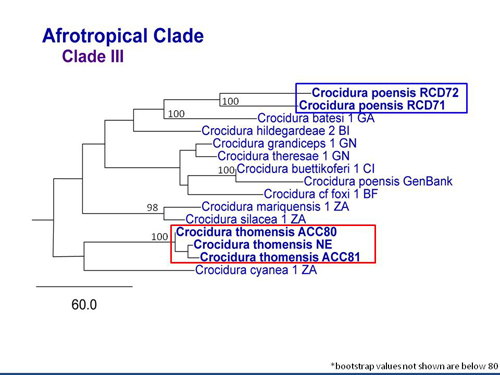
Afrotropical clade III; Eden Maloney construct
Above is a representation of Eden’s Afrotropical Clade III, therelated group within the broad African species clade that includes both our island samples. Our São Tomé species samples are in the red box, and notice that their nearest relative is a mainland species called Crocidura cyanea, a shrew that ranges from Angola, Botswana and Mozambique south into South Africa. C. thomensis is genetically distinct enough from this (it’s nearest relative) and all other species in the tree for us to say with confidence that it is a true endemic. From this we infer that the common ancestor of C. thomensis and C. cyanea somehow reached the island a long, long time ago, long enough for it to have been isolated from the mainland for a great enough period of time to have accumulated enough genetic change so that it is now recognizable as a distinct species. Assuming that our study is accurate and our analysis is correct, Crocidura thomensis is the Gulf of Guinea oceanic islands’ only endemic terrestrial mammal.

Sao Tome's only endemic terrestrial mammal, Crocidura thomensis; R. Lima phot. 2009
We are not quite ready to publish these results though. There is still the problem of the two Príncipe samples, called C. poensis (blue box in the Afrotropical cladogram). The shrews on this island have long been thought to be this particular mainland species but the name is an assumption on our part; there are some missing sequences of C. poensis in Dubey’s study, and until we can clarify the situation, we do not know the correct name for the Príncipe shrew; it is probably either C. poensis or C. batesi, both mainland forms. However, the genetic differences between our Príncipe samples and the other species in Afrotropical Clade III are so small as to strongly suggest that the species is not endemic but rather a recent arrival.
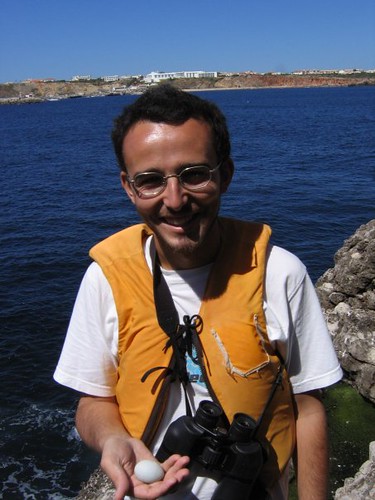
Ricardo Lima in Europe; unknown phot.
Our colleague in this study is Ricardo Lima, who has appeared in this blog a number of times. Ricardo is a doctoral candidate at the University of Lancaster, has been doing his fieldwork on Sao Tome for several years and is an excellent biologist who is deeply concerned with the unique biodiversity of the islands. He has an excellent blog: http://riscas83.blogspot.com/
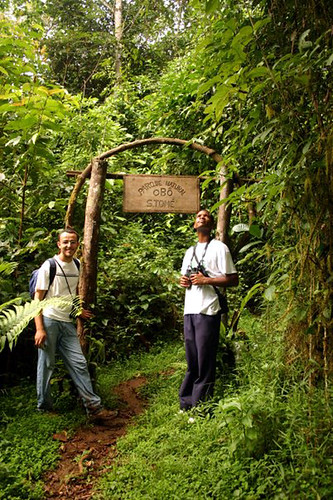 Ricardo Lima on Sao Tome; ] phot.R. Rocha
Ricardo Lima on Sao Tome; ] phot.R. Rocha
Ricardo not only re-discovered the São Tomé shrew (incorrectly thought to be rare), he has also learned more about this species that has ever been known before. He has made and plotted numerous sightings of the species during his fieldwork and has been able to learn a great deal about its abundance and natural history. So, Eden, Ricardo and I will collate his ecological data with our genetic data and publish our results when the remaining issues are all resolved. One other item: I have suggested, perhaps rashly, that Crocidura thomensis may be the only endemic oceanic island shrew in the world; further investigation is needed.
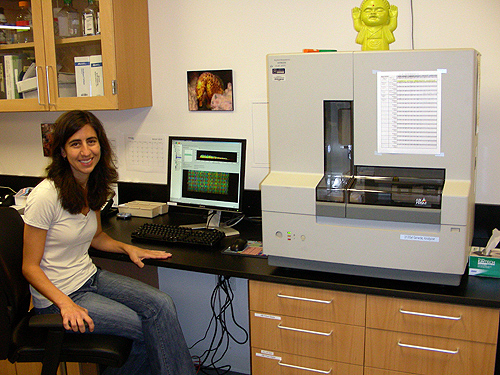
Anna Sellas, Lab Manager, Center for Comparative Genomics; RCD phot.
We are able to ask and answer such finely-tuned, detailed questions of genetic distance about the unique biota of São Tomé and Príncipe because we have the appropriate tools and wonderful people in our lab. The Center for Comparative Genomics is an integral department of the California Academy of Sciences. Headed by Dr. Brian Simison, the lab is managed and run by Anna Sellas, a fine biologist and most able teacher of molecular techniques. Dana Carrison, a member of GG III who did her MSc on island barnacles also works in the lab and greatly assisted Eden.
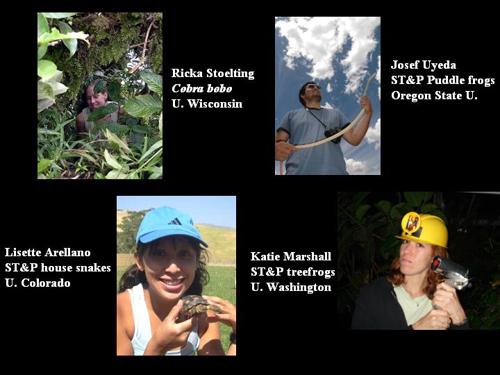 Grad Student Scientists with Gulf of Guinea Projects. RCD construct
Grad Student Scientists with Gulf of Guinea Projects. RCD construct
A number of our interns and grad students who have worked in the field with us have done their analyses of São Tomé and Príncipe projects in the CCG. Four of mine, I am enormously proud to say, have entered or completed doctoral programs-- they appear above. Some of their projects have been published, the rest are still in preparation.
The parting shot:
 Haul-out, south of Neves.. R. Wenk Phot - GG III
Haul-out, south of Neves.. R. Wenk Phot - GG III
PARTNERS
We gratefully acknowledge the support of the G. Lindsay Field Research Fund, Hagey Research Venture Fund of the California Academy of Sciences, the Société de Conservation et Développement (SCD) and Africa’s Eden for logistics, ground transportation and lodging, STePUP of Sao Tome http://www.stepup.st/, Arlindo de Ceita Carvalho, Director General, and Victor Bomfim, Salvador Sousa Pontes and Danilo Barbero of the Ministry of Environment, Republic of São Tomé and Príncipe for permission to export specimens for study, the continued support of Bastien Loloum of Zuntabawe and Faustino Oliviera, Curator of the Herbarium at Bom Sucesso. Special thanks for the generosity of private individuals, George G. Breed, Gerry F. Ohrstrom, Timothy M. Muller, Mrs. W. H. V. Brooke, Mr. and Mrs. Michael Murakami, Hon. Richard C. Livermore, Prof. & Mrs. Evan C. Evans III, Mr. and Mrs. Robert M. Taylor and Velma and Michael Schnoll for helping make these expeditions possible. Our expeditions can be supported by donations to “California Academy of Sciences Gulf of Guinea Fund”.